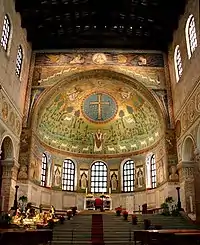Apse
In architecture, the apse (from Latin apsis: "arch, vault") is a semicircular recess covered with a hemispherical vault or semi-dome.[1] It is similar to another form known as an exedra.[2] In Romanesque, Byzantine and Gothic Christian abbey, cathedral and church architecture, the term is applied to a semi-circular or polygonal termination of the main building. This is usually at the liturgical east end (where the altar is). It is also regardless of the shape of the roof, which may be flat, sloping, domed, or hemispherical.

Typical early Christian Byzantine apse
References
- Lilian H. Zirpolo, Historical Dictionary of Baroque Art and Architecture (Lanham, MD: Scarecrow Press, 2010), p. 71
- William Audsley, Popular Dictionary of Architecture and the Allied Arts, Vol 3 (New York: G.P. Putnam's Sons, 1882), p. 77, note †
Wikimedia Commons has media related to Apses.
This article is issued from Wikipedia. The text is licensed under Creative Commons - Attribution - Sharealike. Additional terms may apply for the media files.